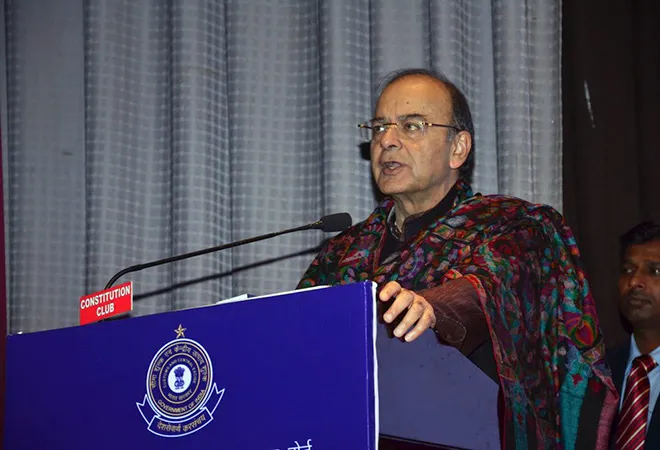
The expectation of a bevy of monetary gifts for the poor in the aftermath of demonetisation was betrayed in the Budget 2017-18. There were no doles given to those who had lost their jobs and were badly hit due to demonetisation. But instead, resuscitation of the rural economy was given high priority. Obviously, a believer of the ‘trickle down’ effect, Finance Minister Arun Jaitley gave the rural economy a huge boost.
Agricultural credit was also allocated Rs 10 lakh crore which is good but that does not guarantee accessibility to the marginal and poorest of poor farmers. Also, increase in investment on irrigation is in the right direction, especially for minor irrigation works. But the problems in agriculture are too many and blanket increase in investments may not benefit the small and marginal farmers who are prone to suicide due to various insecurities. The ‘trickle down’ usually does not work in rural economy.
To directly aim at increasing rural demand has been a persistent theme in the Budget which includes giving a boost to the MNREGA to enhance employment to the poor. The 25 percent raise has already been proved to be illusory, according to experts. But his aim to give 100 days of employment to every household is better than having no jobs at all. The problem with MNREGA is implementation and delayed payments and not a big increase in the kitty.
Giving more purchasing power in the hands of the middle classes by cutting the income tax by half for incomes up to Rs 5 lakhs also has been undertaken with much fanfare to boost demand. Clearly, boosting aggregate demand has been a priority of Mr. Jaitley in his fourth Budget. Like the previous budgets presented by him, there are increases in infrastructure investment and the main item of an increase in public investment is the railways with an allocation of Rs 1.31 lakh crore . Also an investment of Rs 64900 crore in roads is welcome because roads need upkeep and new investment is needed for expansion of the road network. This is vital for the increase in goods and passenger traffic.
He has tread on the beaten path in most other schemes for the poor and an increase in investment on affordable housing is one of them. Housing for the poor has got infrastructure stature, something new this time. Rural electrification, skill development and raising the money given to pregnant mothers have all been visited before. Health and education has also been given due importance and the establishment of two more AIIMS is welcome considering the huge congestion in government hospitals. Improvement in the quality of education was not focussed upon and Sarva Shiksha Abiyan was not given an increase in allocation. The National Health Mission got a boost of 20 percent. But the social pensions for the vulnerable group of widows and the elderly did not get a boost. There was no mention of women in any special way which is surprising — considering the gaping need for increase in their safety, especially in urban India.
On capital expenditure, there has been a move in the right direction. Capital expenditure has been declining both public and private and fixed gross capital formation as a proportion of GDP is 26.5 percent. Jaitley has rightly increased capital expenditure by Rs. 3,09,801 crore with a substantial increase in transfer to the states.
He has gone away from the orthodoxy of sticking to the fiscal deficit as required by the FRBM committee at 3 per cent and has opted for 3.2 percent instead which shows his willingness to expand expenditure in face of an obvious disruption in the economy by demonetisation and the revised estimate of 6.5 percent GDP estimate by the IMF. To the government’s credit, the revenue deficit has shrunk to 2 percent which means the quantum of public borrowing will be less –this was enough to give a boost to the sensex which rose by 486 points.
On a wider canvas, Jaitley with a sweeping brushstroke abolished the FIPB for vetting foreign direct investment. This is in line with the policies that the NDA government has adopted for raising India’s ranking in the World Bank Index of Ease of Doing Business. Less bureaucratic red tape will help -- provided there is a surge in FDI coming to India. Global investment however has receded this year.
Throughout his Budget speech, his thrust was on reviving the economy. The job creation aspect, which is a serious problem for job seeking youth, was kind of missed out. Manufacturing growth has been sluggish and it is one sector which needs to be revamped and incentivised because it offers job creation opportunities for mainly unskilled labour. Otherwise, India is likely to experience job less growth in the future.
Credit offtake has been low and private sector investment has sunk into negative territory. The public sector banks need to be recapitalised and Rs. 10,000 crore that has been granted may not be adequate to make them healthier.
In many ways, the Budget 2017 achieved many firsts — like the dismantling of the FIPB and it was the first joint budget to include the Railway Budget. The difference between Non-Plan and Plan expenditure also have been done away with. On the whole, the Budget 2017 is so widely dispersed that one cannot get a clear picture of the direction in which the economy is heading. The poor have been given ample space and the government has pledged to get one crore people out of poverty. There are many things that have been rightly addressed and many important things have been glossed over. It is a Budget with few frills and lacks a grandiose vision to perk people up.
The views expressed above belong to the author(s). ORF research and analyses now available on Telegram! Click here to access our curated content — blogs, longforms and interviews.




 PREV
PREV


